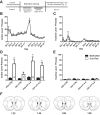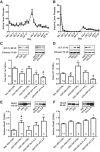Contrasting the Role of xCT and GLT-1 Upregulation in the Ability of Ceftriaxone to Attenuate the Cue-Induced Reinstatement of Cocaine Seeking and Normalize AMPA Receptor Subunit Expression
- PMID: 28495973
- PMCID: PMC5473201
- DOI: 10.1523/JNEUROSCI.3717-16.2017
Contrasting the Role of xCT and GLT-1 Upregulation in the Ability of Ceftriaxone to Attenuate the Cue-Induced Reinstatement of Cocaine Seeking and Normalize AMPA Receptor Subunit Expression
Abstract
Long-term treatment with ceftriaxone attenuates the reinstatement of cocaine seeking while increasing the function of the glutamate transporter 1 (GLT-1) and system xC- (Sxc) in the nucleus accumbens core (NAc). Sxc contributes the majority of nonsynaptic extracellular glutamate in the NAc, while GLT-1 is responsible for the majority of glutamate uptake. Here we used antisense to decrease the expression of GLT-1 and xCT (a catalytic subunit of Sxc) to determine the relative importance of both proteins in mediating the ability of ceftriaxone to prevent cue-induced reinstatement of cocaine seeking and normalize glutamatergic proteins in the NAc of rats. Intra-NAc xCT knockdown prevented ceftriaxone from attenuating reinstatement and from upregulating GLT-1 and resulted in increased surface expression of AMPA receptor subunits GluA1 and GluA2. Intra-NAc GLT-1 knockdown also prevented ceftriaxone from attenuating reinstatement and from upregulating xCT expression, without affecting GluA1 and GluA2 expression. In the absence of cocaine or ceftriaxone treatment, xCT knockdown in the NAc increased the expression of both GluA1 and GluA2 without affecting GLT-1 expression while GLT-1 knockdown had no effect. PCR and immunoprecipitation of GLT-1 revealed that ceftriaxone does not upregulate GLT-1 and xCT through a transcriptional mechanism, and their coregulation by ceftriaxone is not mediated by physical interaction. These data support important and distinct roles for xCT and GLT-1 in the actions of ceftriaxone and add to a body of literature finding evidence for coregulation of these transporters. Our results also point to xCT expression and subsequent basal glutamate levels as being a key mediator of AMPA receptor expression in the NAc.SIGNIFICANCE STATEMENT Ceftriaxone attenuates the reinstatement of cocaine, alcohol, and heroin seeking. The mechanism of action of this behavioral effect has been attributed to glutamate transporter 1 (GLT-1) and xCT (a catalytic subunit of Sxc)/Sxc upregulation in the nucleus accumbens core. Here we used an antisense strategy to knock down GLT-1 or xCT in the nucleus accumbens core and examined the behavioral and molecular consequences. While upregulation of both xCT and GLT-1 are essential to the ability of ceftriaxone to attenuate cue-induced reinstatement of cocaine seeking, each protein uniquely affects the expression of other glutamate receptor and transporter proteins. We also report that reducing basal glutamate levels through the manipulation of xCT expression increases the surface expression of AMPA receptor subunits, providing insight to the mechanism by which cocaine alters AMPA surface expression.
Keywords: glutamate; glutamate transporters; microdialysis; nucleus accumbens; relapse.
Copyright © 2017 the authors 0270-6474/17/375809-13$15.00/0.
Figures








Similar articles
-
Ceftriaxone attenuates cocaine relapse after abstinence through modulation of nucleus accumbens AMPA subunit expression.Eur Neuropsychopharmacol. 2016 Feb;26(2):186-194. doi: 10.1016/j.euroneuro.2015.12.022. Epub 2015 Dec 10. Eur Neuropsychopharmacol. 2016. PMID: 26706696 Free PMC article.
-
Modulatory effects of Ampicillin/Sulbactam on glial glutamate transporters and metabotropic glutamate receptor 1 as well as reinstatement to cocaine-seeking behavior.Behav Brain Res. 2017 Aug 14;332:288-298. doi: 10.1016/j.bbr.2017.06.017. Epub 2017 Jun 15. Behav Brain Res. 2017. PMID: 28624317 Free PMC article.
-
The effects of ceftriaxone on cue-primed reinstatement of cocaine-seeking in male and female rats: estrous cycle effects on behavior and protein expression in the nucleus accumbens.Psychopharmacology (Berl). 2018 Mar;235(3):837-848. doi: 10.1007/s00213-017-4802-7. Epub 2017 Dec 2. Psychopharmacology (Berl). 2018. PMID: 29197981 Free PMC article.
-
Cocaine use disorder: A look at metabotropic glutamate receptors and glutamate transporters.Pharmacol Ther. 2021 May;221:107797. doi: 10.1016/j.pharmthera.2020.107797. Epub 2021 Jan 9. Pharmacol Ther. 2021. PMID: 33359590 Review.
-
Regulation of AMPA receptor trafficking in the nucleus accumbens by dopamine and cocaine.Neurotox Res. 2010 Nov;18(3-4):393-409. doi: 10.1007/s12640-010-9176-0. Epub 2010 Apr 2. Neurotox Res. 2010. PMID: 20361291 Free PMC article. Review.
Cited by
-
A Rat Model of Cocaine-Alcohol Polysubstance Use Reveals Altered Cocaine Seeking and Glutamate Levels in the Nucleus Accumbens.Front Neurosci. 2020 Aug 18;14:877. doi: 10.3389/fnins.2020.00877. eCollection 2020. Front Neurosci. 2020. PMID: 32982672 Free PMC article.
-
Altered glutamate clearance in ascorbate deficient mice increases seizure susceptibility and contributes to cognitive impairment in APP/PSEN1 mice.Neurobiol Aging. 2018 Nov;71:241-254. doi: 10.1016/j.neurobiolaging.2018.08.002. Epub 2018 Aug 7. Neurobiol Aging. 2018. PMID: 30172223 Free PMC article.
-
Elevation of Extracellular Glutamate by Blockade of Astrocyte Glutamate Transporters Inhibits Cocaine Reinforcement in Rats via a NMDA-GluN2B Receptor Mechanism.J Neurosci. 2022 Mar 16;42(11):2327-2343. doi: 10.1523/JNEUROSCI.1432-21.2022. Epub 2022 Jan 28. J Neurosci. 2022. PMID: 35091501 Free PMC article.
-
The effects of Pavlovian cue extinction and ceftriaxone on cocaine relapse after abstinence.Drug Alcohol Depend. 2019 Apr 1;197:83-86. doi: 10.1016/j.drugalcdep.2019.01.005. Epub 2019 Feb 13. Drug Alcohol Depend. 2019. PMID: 30784953 Free PMC article.
-
Involvement of extrasynaptic glutamate in physiological and pathophysiological changes of neuronal excitability.Cell Mol Life Sci. 2018 Aug;75(16):2917-2949. doi: 10.1007/s00018-018-2837-5. Epub 2018 May 15. Cell Mol Life Sci. 2018. PMID: 29766217 Free PMC article. Review.
References
-
- Bannai S. (1986) Exchange of cystine and glutamate across plasma membrane of human fibroblasts. J Biol Chem 261:2256–2263. - PubMed
Publication types
MeSH terms
Substances
Grants and funding
LinkOut - more resources
Full Text Sources
Other Literature Sources
Medical
